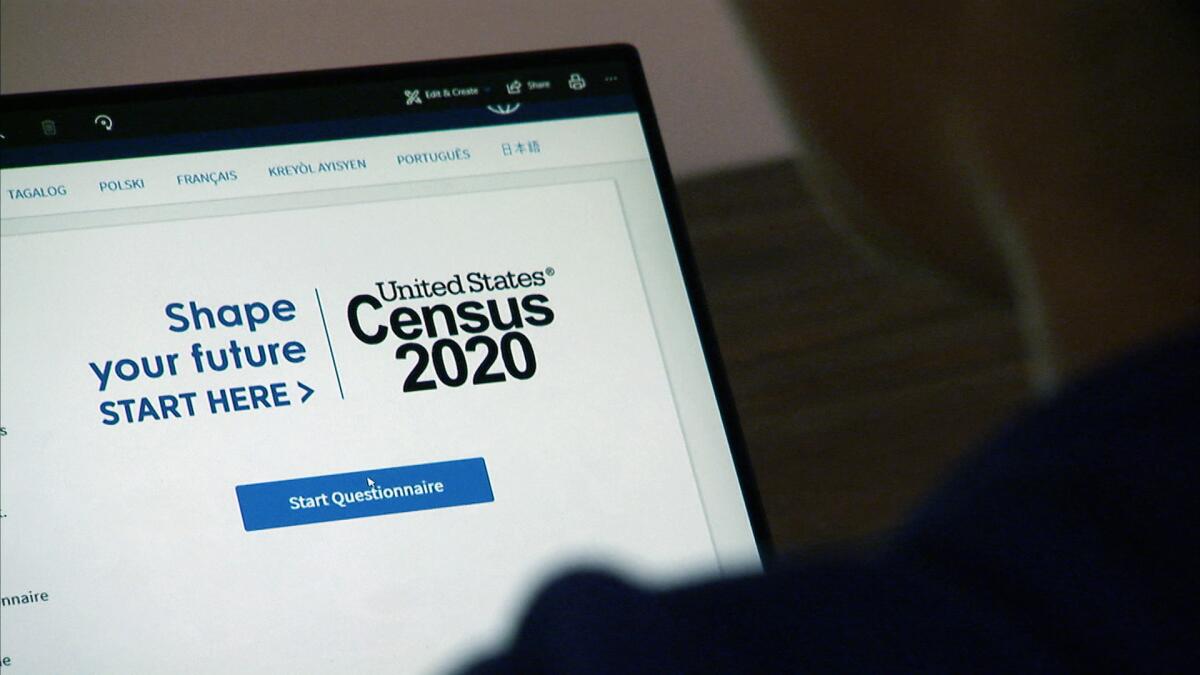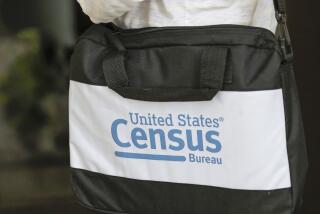Conducting a census during the coronavirus pandemic won’t be easy, but we have to get it right

- Share via
To state the obvious, there’s never a good time for a pandemic. But among the things that make this a particularly bad time is that the United States is in the middle not only of a presidential election, but of the decennial census.
Notices have already been sent out to households across the nation about how to complete census forms online, but the Census Bureau has wisely suspended its outreach workers’ trips into neighborhoods to implore people to participate and to drop off notices at homes that don’t receive regular mail delivery. With much of the nation now living in near-isolation and COVID-19 spreading at stunning levels, this is no time for the government to risk exposing an army of door-knockers to the virus or, worse still, inadvertently spreading it door-to-door.
The problem with pausing the census process, though, is that doing so could affect the population count, particularly in California, where the breadth of our geography (from crowded coasts to sparsely populated deserts and mountainous regions) and immigrant population (about 1 in 4 residents were born in another country) pose significant challenges to census-takers. An artificially low count in this state could lead to a loss of representation in Congress and an unfair reduction in federal aid to California over the next decade.
Wednesday marks the official census day, but that’s not the day the census forms are due (the count continues for several months). Instead, that’s the date anchoring the central questions of the census: where are Americans living on April 1 and who lives there with them?
About a third of the nation’s households have already responded online, but much of the process has been interrupted. In addition to putting outreach efforts on hold, the government has also delayed its calendar for counting people in group housing, interviewing people at homes that did not respond to the initial mailing, and undertaking a count of the homeless. Still, the government says it is confident it will meet its congressionally mandated Dec. 31 deadline to report the basic count of who lives where. How accurate that count will be is unknowable at this point.
There has been some discussion of whether the government should delay the census altogether in the face of COVID-19, but it doesn’t have much flexibility beyond tinkering minimally with its calendar. The U.S. Constitution mandates a census every 10 years to provide the population statistics for reapportioning seats in the House of Representatives. But the Constitution left it up to Congress to handle the details, which it has done with occasional updates since just after the birth of the nation.
Over more than two centuries, the government has conducted 23 counts (this year’s is the 24th), some in very trying circumstances, including on the eves of the Civil War and World War II. It has not always gone smoothly. In 1920, in fact, political disputes over the census — in particular, European immigration to northern cities and the great migration from the rural South to northern cities, which threatened to shift power in the House — led Congress to forego that year’s reapportionment. House districts remained as they were until after the 1930 census, which came as the nation was sliding into the Great Depression.
Fortunately, and only coincidentally, the government hopes the current census will be conducted mostly online, by mail or over the phone, which will minimize personal contact and potential spread of the coronavirus. But much like the social distancing required to stem the pandemic, that only works if people submit their census answers as they are asked to. The higher the self-response rate — it was 66.5% in 2010 — the less work the government has to do in the coming months to track down non-responders and badger people for the answers to basic census questions.
We should note that this census count was already facing a compliance challenge in immigrant communities because of fears that the Trump administration might use the census information to boost deportations (in fact, it is illegal for the census to share any of the information it collects for 72 years). Meanwhile, the outbreak compounds the difficulties in counting the homeless, another hard-to-reach segment of the population.
It is incumbent on the federal government to get the count right. But it’s also critical that the state continue its campaign as best it can to encourage Californians to participate. Even before the virus hit, California was one of 10 states at risk of losing House seats in the next reapportionment. So we must not be undercounted — there’s just too much at stake.
More to Read
A cure for the common opinion
Get thought-provoking perspectives with our weekly newsletter.
You may occasionally receive promotional content from the Los Angeles Times.









